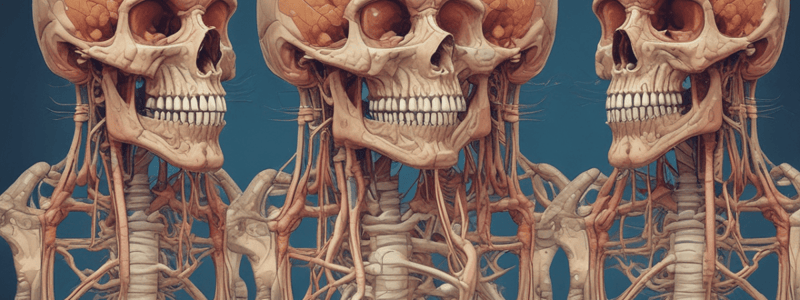Podcast
Questions and Answers
What type of epithelia is found in excretory ducts?
What type of epithelia is found in excretory ducts?
- Cuboidal
- Squamous
- Pseudostratified or stratified (correct)
- Simple columnar
Which gland is located between muscle fibers, below the circumvallate and foliate papillae?
Which gland is located between muscle fibers, below the circumvallate and foliate papillae?
- Submandibular gland
- Von Ebner gland (correct)
- Weber gland
- Blandin-Nuhn gland
What is the function of the secretion of Von Ebner gland?
What is the function of the secretion of Von Ebner gland?
- Moisturizing the food
- Washing out the trough of papillae and readying the taste receptors for a new taste stimulus (correct)
- Breaking down carbohydrates
- Regulating body temperature
Which glands are associated with the lingual tonsils?
Which glands are associated with the lingual tonsils?
What is the composition of saliva?
What is the composition of saliva?
What are the two components of salivary glands?
What are the two components of salivary glands?
What type of cells are involved in the secretion of thin, watery, and proteinaceous substances?
What type of cells are involved in the secretion of thin, watery, and proteinaceous substances?
Which gland secretes the majority of saliva?
Which gland secretes the majority of saliva?
Where do terminal secretary units drain into?
Where do terminal secretary units drain into?
What is the function of enzymes in saliva?
What is the function of enzymes in saliva?
Where do the ducts of Weber glands open?
Where do the ducts of Weber glands open?
What is the function of the Golgi complex in serous cells?
What is the function of the Golgi complex in serous cells?
What is the significance of intercellular canaliculi in serous cells?
What is the significance of intercellular canaliculi in serous cells?
What is the characteristic shape of serous cells under light microscopy?
What is the characteristic shape of serous cells under light microscopy?
What is the size of the secretory granules in the apical cytoplasm of serous cells?
What is the size of the secretory granules in the apical cytoplasm of serous cells?
What type of protein is found in the secretory granules of serous cells?
What type of protein is found in the secretory granules of serous cells?
What is the main function of the ductal system in salivary glands?
What is the main function of the ductal system in salivary glands?
What type of cells line the intercalated ducts?
What type of cells line the intercalated ducts?
What is the characteristic feature of striated ducts under electron microscopy?
What is the characteristic feature of striated ducts under electron microscopy?
What is the role of striated ducts in saliva secretion?
What is the role of striated ducts in saliva secretion?
What type of cells are present in terminal excretory ducts near striated ducts?
What type of cells are present in terminal excretory ducts near striated ducts?
Where are terminal excretory ducts located?
Where are terminal excretory ducts located?
What is the function of the striated border in striated ducts?
What is the function of the striated border in striated ducts?
What type of ducts merge with oral epithelium at the duct orifice?
What type of ducts merge with oral epithelium at the duct orifice?
Flashcards are hidden until you start studying
Study Notes
Excretory Ducts and Lingual Glands
- Excretory ducts have pseudostratified or stratified epithelia.
- Anterior lingual glands are also known as Blandin-Nuhn glands, located at the tip of the tongue, ventral surface, and lingual frenum.
- Posterior lingual glands consist of Von Ebner gland and Weber gland.
Von Ebner Gland
- Located between muscle fibers, below the circumvallate and foliate papillae.
- Functions include washing out the trough of papillae and readying taste receptors for a new taste stimulus, and contains antibacterial and lipolytic enzymes for protective and digestive purposes.
Weber Glands
- Located in the posterior one-third of the tongue, associated with lingual tonsils.
- Ducts open on the dorsal surface of the tongue through lingual crypts.
Composition of Saliva
- 99% water and 1% of organic and inorganic substances.
- Organic substances include enzymes, mucins, and antibacterial substances, with minor quantities of albumin, blood clotting factor, and immunoglobulin IgA.
- Inorganic substances include sodium, chloride, bicarbonate, and smaller amounts of calcium, magnesium, phosphate, iodine, thiocyanate, and fluoride.
Volume of Saliva
- Majority is secreted by the submandibular gland, followed by the parotid and sublingual glands.
- The least amount is secreted by minor salivary glands.
Functions of Saliva
- Not specified in the provided text, but salivary gland histology and function will be discussed later.
Structure of Salivary Glands
- Composed of epithelial and connective tissue components.
- The epithelial component is called parenchyma, supported by connective tissue.
Secretory Units
- Consist of serous cells, mucous cells, and myoepithelial cells.
Duct System
- Consists of intercalated ducts, striated ducts, and terminal excretory ducts.
- Terminal secretary units drain into ducts, which are then divided into intercalated ducts, striated ducts, and finally, excretory ducts that open into the oral cavity.
Component of Terminal Secretory Units
- Serous cells secrete thin, watery, and proteinaceous substances.
- Mucous cells secrete mucins.
Serous Cells/Serous Acini
- Pyramidal in shape, with spherical nuclei located basally.
- Contain numerous secretory granules in the apical cytoplasm.
- 8-12 cells surround a central lumen, with cytoplasm intensely stained with H & E and nucleus stained with hematoxylin.
Electron Microscopy of Serous Cells
- Protein-secreting cell with a central lumen and intercellular canaliculi.
- Large amounts of RER are placed basally and laterally to the nucleus.
- Prominent Golgi complex is located just apical or lateral to the nucleus.
- Apical cytoplasm is filled with secretory granules that are +ve for PAS Stain.
Ductal System and Ductal Modification
- The ductal system is responsible for production and modification of saliva.
- It consists of three types of ducts: intercalated, striated, and terminal ducts.
Intercalated Ducts
- Lined by a single layer of low cuboidal cells.
- Contain a few secretory granules, with a round/oval centrally placed nucleus and empty-appearing cytoplasm.
- Small amounts of RER are located in the basal cytoplasm.
Striated Ducts
- Lined by columnar cells with a central placed nucleus.
- Pale, acidophilic cytoplasm.
- Electron microscopy shows prominent striations at the basal part of cells, numerous elongated mitochondria in narrow cytoplasmic, and few rER and Golgi complexes around the nucleus.
- Luminal surface has microvilli, and desmosomal attachment is present.
Function of Striated Ducts
- Involved in secretion and reabsorption of water and electrolytes.
- Striated border acts as a sodium-pumping machine, reabsorbing sodium and chloride, and secreting potassium and bicarbonate ions to make isotonic secretion to hypotonic secretion.
Terminal Excretory Ducts
- Located in connective tissue septa, i.e., an extra-lobular location.
- Larger in diameter than striated ducts.
- Near striated duct, pseudostratified tall columnar cells are admixed with small basal cells and goblet cells.
- Tall columnar cells merge with oral epithelium at the duct orifice.
Studying That Suits You
Use AI to generate personalized quizzes and flashcards to suit your learning preferences.





